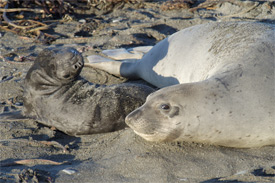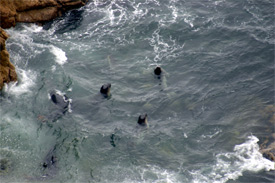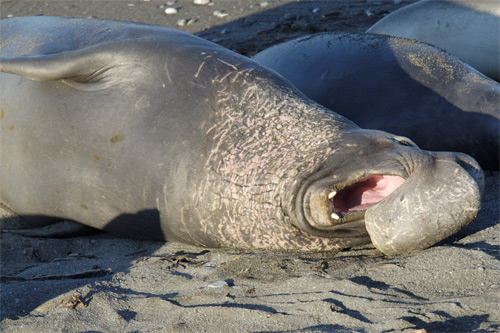
Elephant seals, genus Mirounga, consists of two species: angustirostris, which exists in the northern hemisphere (northern elephant seal) and leonine, which exists in the southern hemisphere (southern elephant seal). Unlike sea lions, they have no external ear flaps, and their rear flippers cannot be rotated forward for locomotion on land, making them true seals. Males can reach 3.82 m (12.5 ft) in length and 1,704 kg (3,756 lbs) in weight, while the much smaller females attain lengths of 2.65 m (8.7 ft) and weigh up to 489 kg (1,078 lbs). Elephant seals are piscivorous (meaning that their diet is made up primarily of fish), and feed by diving and actively chasing their prey. Some individuals have been recorded diving to depths of 1,500 m (4,921 ft), and staying submerged for over an hour. The range of the northern elephant seal extends from Baja Mexico to the Aleutian Islands, although the National Marine Fisheries Service considers the California population a separate subspecies from the Baja Mexico population.
Before the harvesting of the northern elephant seals began in the early 1800’s there were hundreds of thousands of northern elephant seals inhabiting the islands, haul-outs, and rookeries on the West Coast. Elephant seals were hunted for their blubber, which was rendered into extremely valuable oil. In 1874 Charles Melville Scammon recorded in “Marine Mammals of the Northwestern Coast of America,” that a bull caught on Santa Barbara Island yielded 210 gallons of oil. Elephant seal blubber was considered at the time to be a better mechanical lubricant than whale blubber. By the late 1800’s, northern elephant seals had become nearly extinct. In the same 1874 zoological study, Scammon wrote: “Owing to the continual pursuit of the animals, they have become nearly if not quite extinct on the California coast, or the few remaining have fled to some unknown point for security.”

Despite the extirpation of elephant seal colonies from California, small groups were continuously found on Guadalupe Island off the Coast of Baja Mexico, and on the mainland of Baja Mexico. In 1880, 335 seals were found at Bahia San Cristobal, on the Coast of Baja Mexico, all of which were killed by poachers within 4 years of their discovery. In 1883, 80 seals were found on Guadalupe Island, all of which were subsequently killed. In 1892, 9 seals were found on Guadalupe Island, of which 7 were harvested for the collection at the Smithsonian Institution in Washington, DC. Against all odds, the last remaining (and very small) colony on Guadalupe Island continued to grow, but was repeatedly exploited by hunters and museum collectors until 1922, when the Mexican Government finally put an end to elephant seal hunting by making Guadalupe Island a biological reserve and conferring protection to the seals. When elephant seals began reappearing in Southern California a few years later, the U.S. Government followed the Mexican Government in elephant seal protection. Each of the nearly 160,000 elephant seals that exist today as a result of protection granted by the Mexican Governments are all descendants of that small colony of between 20 and 100 individuals on Guadalupe Island.
Today, under the protection of the California Department of Fish and Game, the elephant seal population in California continues to grow. The largest elephant seal colonies in North America, including Año Nuevo State Reserve, Año Nuevo Island, and Piedras Blancas, are all within or adjacent to the Monterey Bay National Marine Sanctuary (MBNMS). Elephant seals draw such crowds on the Pacific Coast Highway (Highway 1), that in 1997, the state of California along with San Luis Obispo County re-routed Highway 1 in order to accommodate tourists and spectators stopping and parking along the road to see elephant seals. The result was a large, unpaved parking lot off the main highway in San Simeon, which includes walkways for pinniped aficionados. At the same time, San Luis Obispo County Supervisor Bud Laurent (now retired) secured funding for docents to educate visitors about the northern elephant seal. Employees of Bay Net, a San Francisco based non-profit organization initiated with the help of the MBNMS, soon began docent training. Within a year, Friends of the Elephant Seal (FES) was formed by the first group of docents trained by Bay Net and became the official local docent volunteer organization. They are crucial to the conservation and future success of the elephant seals, having provided elephant seal education and outreach to more than 750,000 visitors since its inception.

Links to More Information
References
- California State Parks. “Elephant Seals.” Last accessed 23 February, 2009 from: <http://www.parks.ca.gov/?page_id=1115>
- Friends of the Elephant Seal, 2009. “The Beginning.” Personal communication.
- National Oceanic and Atmospheric Administration. “Special Status Species: Northern Elephant Seal (Mirounga angustirostris).” Last accessed 23 February, 2009 from: <http://www.sanctuarysimon.org/monterey/sections/specialSpecies/elephant_seal.php>
- Scammon, C.M., 1874. “Marine Mammals of the Northwestern Coast of North America.” NOAA Historical Archives.
- West, K. “Northern Elephant Seals.” Last accessed 23 February, 2009 from : <http://www.pelicannetwork.net/elephant.seal.history.htm>